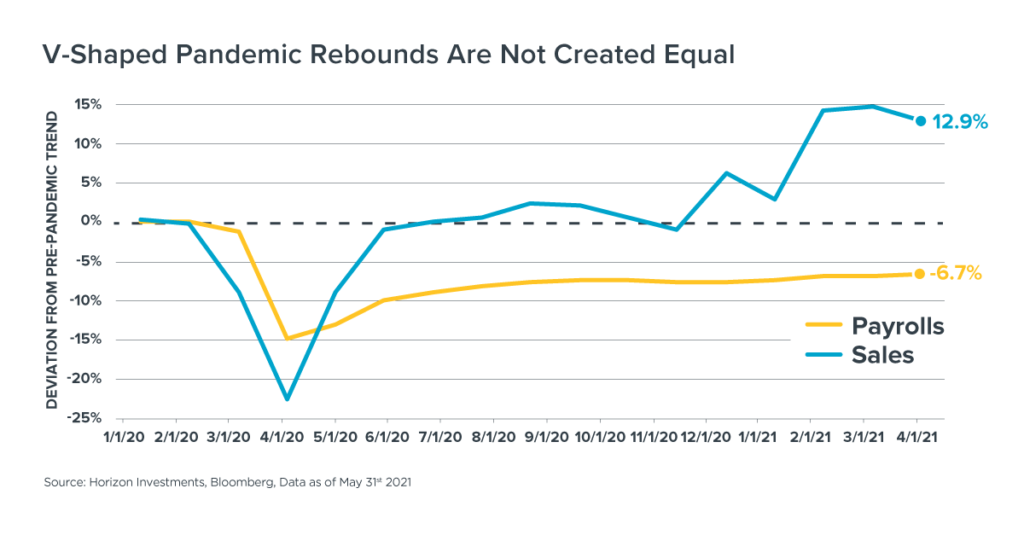Capturing the pandemic’s weird real-world effects is reflected in how high above trend retail sales are, at 12.9%, versus how far below trend employment is, at -6.7%
Wouldn’t it be great to “return to normal” now that Covid appears to be receding in the U.S.?
To get back to the pre-pandemic way of life, however, will probably be anything but simple and straightforward in many cases, considering how off-kilter they are, currently.
To capture the economic weirdness in one chart, Horizon Investments compared the changes in retail sales and employment starting in January 2020 against their five-year, pre-Covid trend. If they were back on trend, their deviation would be 0% in the chart below. But that’s not what you find.
Retail sales are running 12.9% above the five-year, pre-pandemic trend as of May, boosted by spending on new and used cars and an uptick in dining out. Meanwhile, the level of employment is 6.7% below trend. The divergence is all the more extraordinary since one might assume that spending and employment would move in tandem.
Why are these two trends diverging, especially as the economy reopens this year?
The recent wave of spending may be explained by the multi-trillion dollar infusions of money into pandemic relief and unemployment insurance programs, the continued employment of white-collar workers and the successful distribution of effective vaccines. Horizon Investments believes that such an unusually strong pace of spending will be difficult to sustain, and people will balk at paying much higher prices (see our Market Notes report on the surge in spending on durable goods and our Big Number on Americans’ negative view of home buying). Indeed, May’s retail sales report shows nascent signs of a turn back toward its pre-pandemic trend for those very reasons.
As for employment, one labor market measure is back to pre-pandemic levels: the percentage of people who say jobs are plentiful. The splurging American consumer has prompted businesses of all sizes to put up `help wanted’ signs. In the latest U.S. job openings report from the Labor Department, a record 9.29 million openings were listed in April — that’s 2.6 million more job openings than in December 2019.
The question is whether people will apply for work. Horizon Investments is hopeful that as unemployment insurance checks shrink and starting wages rise, employment will show strong gains. But that evidence may not come for a while. The 25 U.S. states that announced they are rolling back the extra pandemic unemployment payments will take several weeks to implement changes. Horizon believes the timeline suggests the July employment report – slated to be released on August 6 – would be the earliest date for a hiring wave to be reflected in the data.
Horizon believes financial advisors should be prepared for a lengthy stretch of time of guiding clients through economic data that will likely be anything but “normal” amid numerous supply and demand mismatches. Developing financial plans focused on achieving goals and working with clients to stick to those plans, especially during times of uncertain headlines, can be an important part of seeking successful investment outcomes.
To download a copy of this commentary, click the button below.
Further reading:
Home Prices to the Moon? Americans Say ‘No Thanks’
Pandemic’s Effect Erased in Job Market; Are We Back to Normal?
Does High-Flying Crypto Below Fit Into Goals-Based Financial Plans
Capital Gains Taxes and S&P 500 Returns: Complete Strangers for Over 60 Years
Americans Taking Early Retirement May Benefit from a Goals-Based Solution
Many Investors Tried to Trade the Pandemic Plunge in Stocks
If Inflation Returns, Bond’s Diversification Power May Disappear
Essentially Nothing. That’s How Much Bonds May Return Over Next Five Years
This commentary is written by Horizon Investments’ asset management team. For additional commentary and media interviews, please reach out to Chief Investment Officer Scott Ladner at 704-919-3602 or sladner@horizoninvestments.com.
To discuss how we can empower you please contact us at 866.371.2399 ext. 202 or info@horizoninvestments.com.
Nothing contained herein should be construed as an offer to sell or the solicitation of an offer to buy any security. This report does not attempt to examine all the facts and circumstances that may be relevant to any company, industry or security mentioned herein. We are not soliciting any action based on this document. It is for the general information of clients of Horizon Investments, LLC (“Horizon”). This document does not constitute a personal recommendation or take into account the particular investment objectives, financial situations, or needs of individual clients. Before acting on any analysis, advice or recommendation in this document, clients should consider whether the security in question is suitable for their particular circumstances and, if necessary, seek professional advice. Investors may realize losses on any investments. Index information is intended to be indicative of broad market conditions. The performance of an unmanaged index is not indicative of the performance of any particular investment. It is not possible to invest directly in an index.
Past performance is not a guide to future performance. Future returns are not guaranteed, and a loss of original capital may occur. This commentary is based on public information that we consider reliable, but we do not represent that it is accurate or complete, and it should not be relied on as such. Opinions expressed herein are our opinions as of the date of this document. These opinions may not be reflected in all of our strategies. We do not intend to and will not endeavor to update the information discussed in this document. No part of this document may be (i) copied, photocopied, or duplicated in any form by any means or (ii) redistributed without Horizon’s prior written consent.
Other disclosure information is available at hinubrand.wpengine.com.
Horizon Investments and the Horizon H are registered trademarks of Horizon Investments, LLC
©2021 Horizon Investments LLC

